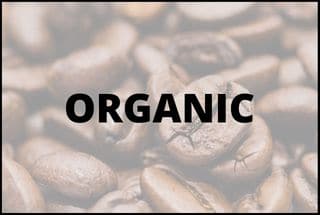The Best Low Acid Coffee Beans in 2022 — Buyer’s Guide, Reviews, and Comparisons
Coffee is packed with acids, and they create the flavor we all love. However, those acids can also negatively impact some people’s digestive systems. Low acid coffee brands provide a flavorful alternative to regular coffee. While these beverages may not be as bold as the original versions, you don’t have to give up quality for your health.
- Uses only Arabica beans
- Natural processing with spring water and sunlight
- Money-back guarantee if you’re not happy
Low Acid Coffee Beans Comparison Table
| IMAGE | PRODUCT | DETAILS | ||
|---|---|---|---|---|
Best Overall  | Best Overall |
Features
| Check Price At Amazon Lifeboost Low Acid Review | |
Best Non-Traditional Low Acid Coffee  | Best Non-Traditional Low Acid Coffee |
Features
| Check Price At Amazon Tieman's Fusion Review | |
Best Organic Low Acid Coffee 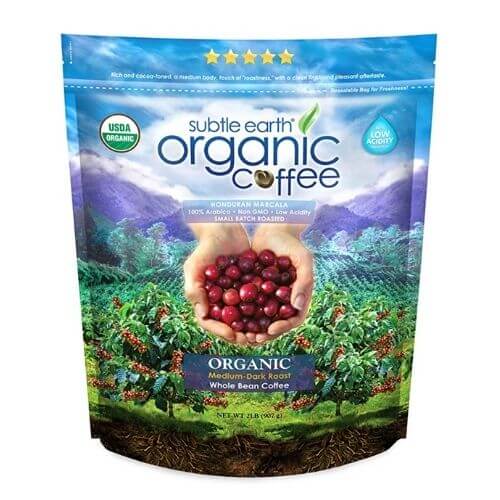 | Best Organic Low Acid Coffee |
Features
| Check Price At Amazon Subtle Earth Review | |
Best Colombian Low Acid Coffee  | Best Colombian Low Acid Coffee |
Features
| Check Price At Amazon Healthwise Gourmet Review | |
Best Medium Roast 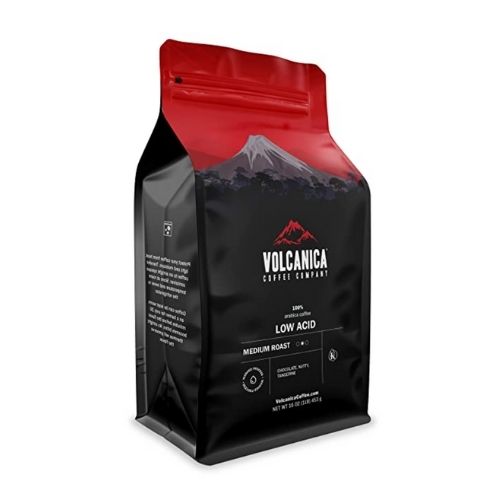 | Best Medium Roast |
Features
| Check Price At Amazon Volcanica Low Acid Review | |
Budget-Friendly 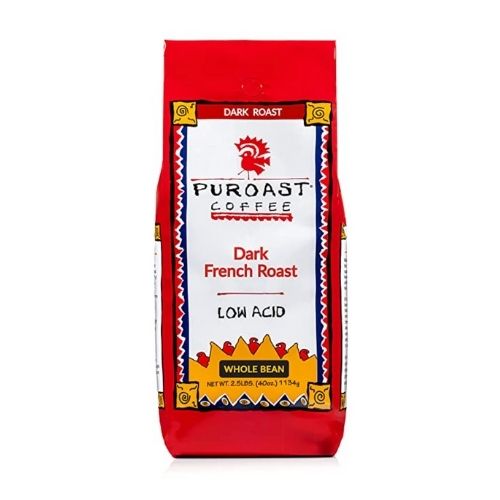 | Budget-Friendly |
Features
| Check Price At Amazon Puroast Coffee Review | |
Best Premium Pick 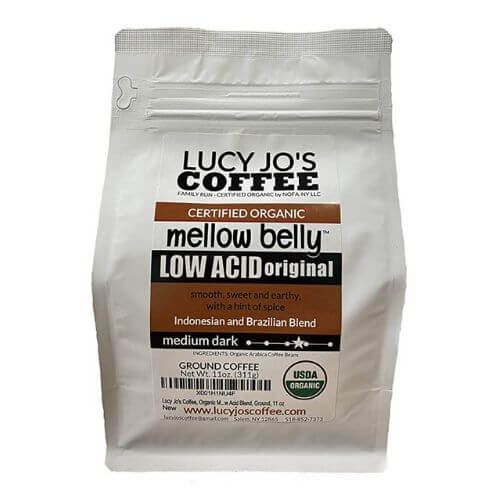 | Best Premium Pick |
Features
| Check Price At Amazon Lucy Jo's Review | |
pH Neutral Coffee 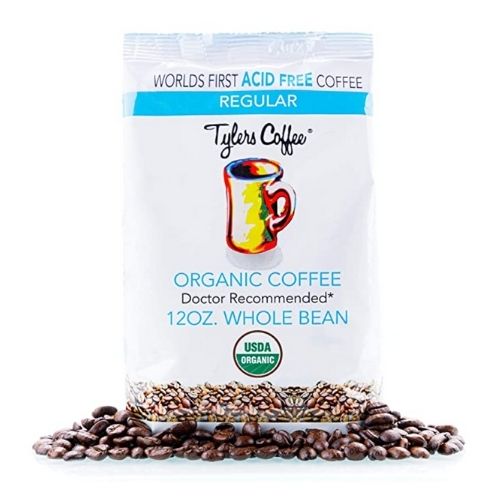 | pH Neutral Coffee |
Features
| Check Price At Amazon Tyler's Coffee Review | |
Best Option for Less Caffeine  | Best Option for Less Caffeine |
Features
| Check Price At Amazon Mommee Coffee Review | |
Best Low Acid Coffee Beans Single Origin 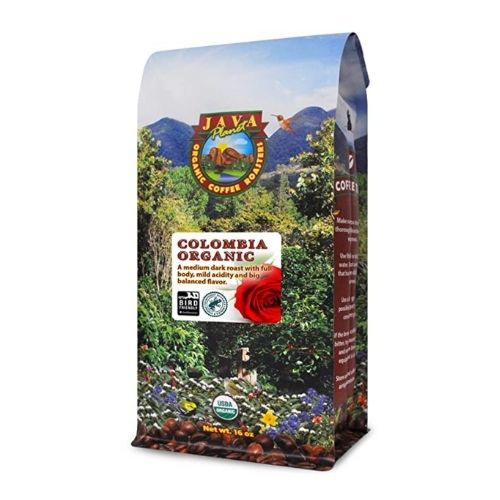 | Best Low Acid Coffee Beans Single Origin |
Features
| Check Price At Amazon Java Planet Review | |
Best Blended Low Acid Coffee 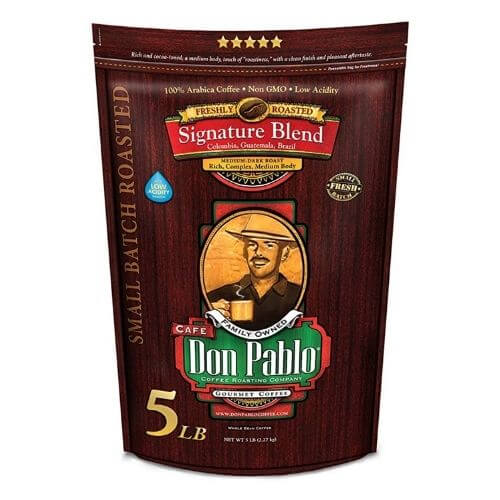 | Best Blended Low Acid Coffee |
Features
| Check Price At Amazon Don Pablo Review |
In a hurry? Skip to our reviews of our top picks:
- Lifeboost Low Acid Organic Coffee
- Tieman’s Fusion Coffee – Dark Roast, Low Acid
- Subtle Earth Organic Coffee Low Acidity
- HealthWise Gourmet Low Acid Coffee
- Volcanica Coffee Low Acid Ground Coffee
- Puroast Low Acid Coffee
- Lucy Jo’s Coffee Mellow Belly Low Acid Blend
- Tyler’s Coffee No Acid Organic Coffee Beans
- Mommee Coffee – Half Caff, Low Acid Coffee
- Java Planet Coffee Beans, Low Acid
- Don Pablo Signature Blend Low Acidity
Low Acid Coffee: A Buying Guide
Coffee is one of the most popular drinks in the world, and many of us are eternally grateful for it in the mornings.
But what happens if coffee starts leading to stomach or acid reflux issues when you drink it? That’s where low acid coffee comes in.
While acid gives coffee some of its most distinct flavors, it can also result in unpleasantness for people sensitive to acid. With low-acid coffee, the beans are roasted in a way that prevents much of the acid from forming.
People with stomach issues may find the best coffee for sensitive stomachs is a low acid version.
Things to consider when selecting low acid coffee:
The pH level
Type of roast
Type of beans
Naturally low-acid or treated?
What is pH?
Without getting too technical, the pH scale indicates how acidic or basic a liquid is. Ranging from 0-14, with 0 indicating the most acid (think battery acid), and 14 indicating the most basic (drain cleaner).
Water is neutral, with a pH of 7. For reference, regular caffeinated coffee has a pH of about 5.
Safe to consume acidic liquids have a sharp taste that’s sometimes sour or tart. A basic solution will taste milder, but bitter. Not that you should go around sampling liquids!
Coffee is naturally acidic, according to the pH scale.
Acids in Coffee
When talking about acid in relation to coffee, it can get very complex, and there are differences between acids and acidity.
According to Healthline, there are several acids present in coffee. These acids, which are characterized by their chemical structure, are a result of roasting and help create java’s distinct flavor.
Acidity can refer to both the taste of the beverage or its pH level. When referencing flavors, acidity can mean sharp, bright, or tangy, all characteristics appreciated by coffee connoisseurs.
In terms of pH level, an acidic beverage will have a pH value of less than 7. Most regular coffee has a pH value of around 5.
You might think there’s little difference between a pH of 5 and a neutral pH of 7. However, the pH scale is logarithmic, meaning any small change in the number indicates a dramatic change in acidity. It’s kind of like the Richter scale for earthquakes.
Why Drink Low Acid Coffee?
There are many reasons to try the best non-acidic coffees. These brands offer the same health benefits as regular coffee. And it goes without saying that people with sensitive stomachs crave caffeine, even if they don’t crave the digestive discomfort!
While there’s a lack of evidence that this discomfort is related to coffee’s acidity, it’s certainly possible that acid could irritate a sensitive stomach. It’s also possible that regular java can exacerbate symptoms of health conditions such as acid reflux or ulcers.
Coffee can also damage tooth enamel, the outermost part of a tooth. Acidic food and drink can harm enamel over time, and that includes coffee, juices, and sodas. Enamel can not only wear down in spots, but it can also stain. The darker the beverage, the more staining it can cause. Beverages with less acid may help prevent that kind of damage to your teeth.
Minimizing Coffee Acidity
Besides choosing low-acid coffee beans, there are some things you can do yourself to minimize acid content even further.
- Longer steeping time – The longer beans steep, the more acids break down, and it doesn’t necessarily take that long. You may find a difference if you steep your coffee for six minutes instead of three minutes, for example.
- Brew at a lower temperature – Hotter water emphasizes acid in java, so lower the water temperature by a few degrees. This, along with a longer steeping time, is why cold brewing is a great option for people who don’t tolerate coffee well.
- Add dairy or plant milk to your coffee – This can help reduce the effects of acid.
How Do You Choose the Best Tasting Low Acid Coffee?
Where the Beans Were Grown
Some people don’t care where their cup of joe comes from, and there’s absolutely nothing wrong with that. However, others have definite preferences about where their coffee originated.
There are certain regions of the world where the coffee grown is less acidic than other areas. The most common regions for low acid coffee are Central and South America, some parts of Indonesia, and certain areas in Ethiopia. Coffee grown in other areas tends to be more acidic, but this isn’t a hard and fast rule.
The most notable factor in less acidic coffees is that these plants are grown at lower elevations than regular coffee. Higher elevations are preferred for growing more acidic coffee with a bolder flavor.
Type of Roast
Nearly everyone has a preferred coffee roast, be it light, medium, medium-dark, and dark.
So does roast level affect the acidity of coffee? Yes and no.
Darker roasts do tend to be less acidic. To reach a dark roast, beans are roasted for longer, and some acids burn off more during that process. Since lighter roasts aren’t roasted for as long, those acids don’t always burn off. Darker roasts also usually contain less caffeine, which is loosely correlated with less acid.
There are more options for coffee with low acid in medium and dark roasts. That’s not to say there aren’t any low-acid light roasts, just that they’re not very common.
Type of Beans
The most common coffee beans are Arabic and Robusta. They aren’t the only ones, but they make up most of the java market. Arabica beans are usually preferred as they have an extensive range of flavors with a smooth taste.
Arabica beans are typically more expensive, and one reason for that is because they’re more difficult to grow. They don’t contain as much caffeine as Robusta beans.
Robusta beans grow more easily but contain more caffeine. They also have a stronger, harsher flavor, and they’re preferred for drinks like espresso. Because Arabica beans are better suited to a wider range of drinks, they’re typically used in low acid coffees, even though Arabica beans are more acidic than Robusta beans.
If you’d like to read about some other differences between Arabica beans and Robusta beans, you can click here.
Inadvertent Low-Acid or Treated
There are two types of low acid coffee. One is inadvertent low acid coffee, which means that low acid occurs naturally in beans grown in certain conditions and regions.
With treated coffee, the beans may be naturally more acidic, but the processing or roasting methods are altered to reduce acid. For example, beans may be roasted slower, or the process may be interrupted repeatedly to reduce the formation of acid.
The Top Eleven Best Low Acid Coffee Options
Obviously, there’s a lot of information to filter through when selecting the best low-acidity coffee. With that in mind, we’ve done that hard work for you and researched the best low acid coffee brands, based on customer feedback, information, and reviews.
Let’s get started with our top pick, Lifeboost’s low-acid brew.
Our Rating: 4.8/5
FEATURES:
- Uses only Arabica beans
- Natural processing with spring water and sunlight
- Money-back guarantee if you’re not happy
Lifeboost Low Acid Coffee is a contender on many ‘best coffee’ lists, not just those covering low acid coffee. The company is known for ethically sourcing coffee beans and using natural methods whenever possible.
Made from 100% Arabica beans, Lifeboost states its low acid coffee has a pH of 6 or higher. This coffee suits French press, pour-over, drip, and espresso. Certified organic by the USDA, the beans are single-origin from Nicaragua. Grown in shaded mountain areas, the beans are washed with spring water and dried in sunlight.
In terms of flavor, expect warm chocolate with hints of nuts and fruits. A premium product, this is the most expensive coffee, per ounce, on our list, which may be offputting to some consumers.
Lifeboost sources beans from Nicaragua only, so if you’re hoping for other regions, keep receiving the options below.
Pros
- Single-origin from Nicaragua
- Third-party tested for mycotoxins and heavy metals
- Natural bean washing and drying methods
Cons
- Pricier than other low acid coffee beans
- Flavor
- Freshness
- Price
Our Rating: 4.6/5
FEATURES:
- Fused with Rooibos red tea, Matcha green tea, and Goji berry powder
- Contains more antioxidants than regular coffee
- Steady release of caffeine, without jitters
Tieman’s low acid coffee is a little out of the box compared to other coffees. Fused with Goji berry, Rooibos red tea, and Matcha green tea powders, it’s truly a unique blend.
Rooibos red tea is thought to soothe the stomach, while Goji berry has anti-inflammatory properties.
Available in whole beans or ground sourced from Central and South America, Tieman’s coffee offers up a rich, dark roast.
When brewed, the chocolate and hazelnut flavors shine. Some people are caught off-guard by the difference in flavor courtesy of the green tea fusion, but we think it’s great!
Caffeine is released steadily rather than all at once, so you needn’t worry about caffeine jitters, or the crash when the boost wears off.
Pros
- Has even more antioxidants than regular coffee
- No caffeine jolt, just a steady stream
- Has soothing and anti-inflammatory properties
Cons
- The unique tea fusion flavor in this coffee isn’t everyone’s cup of… well, tea
- Flavor
- Freshness
- Price
Our Rating: 4.7/5
FEATURES:
- Roasted in small batches
- Rich, sweet chocolate flavor
- Certified organic
Subtle Earth Coffee is organic, and the company participates in the sharing certified program. Much like Fair Trade, this program ensures fair wages for the workers growing and harvesting the coffee beans.
Reportedly testing around 6 on the pH scale, this coffee is made with Arabica beans from Honduras. These single-origin beans are roasted in small batches, and this beverage has a smooth, sweet taste. In fact, some people have complained that the flavor is a bit too sweet.
You also may have to experiment to find the perfect ratio of ground coffee and water. Low acid coffee can sometimes be a little weaker than the regular stuff, so you should use more ground coffee if you want to strengthen its flavor.
Pros
- Single-origin coffee beans.
- Slow roasted in small batches.
- Workers are paid fair wages.
Cons
- The flavor may be too sweet for some people
- Experimentation may be needed to find the right ratio of water and coffee
- Flavor
- Freshness
- Price
Our Rating: 4.5/5
FEATURES:
- Techno Roasting process reduces acid
- Made in a nut-free facility to reduce allergens
- Mellow but rich flavors
Moderately priced, HealthWise Coffee uses its own special roasting process known as Techno Roasting. The company says this reduces acid from forming during the roasting process and that the resulting coffee has a pH of 6.18.
If allergies are a concern, you won’t have to worry about cross-contamination as the production facility is nut-free. The coffee is made with Arabica beans sourced from the Colombian region.
While it has a bit less caffeine than regular java, at 70 mg per serve, this coffee contains higher than average amounts of micronutrients, vitamins, and minerals. Expect a mellow, but rich taste.
Pros
- Techno Roasting process is used to reduce acids
- Made in a nut-free facility to reduce allergens
- Contains higher levels of micronutrients than regular coffee
Cons
- The flavor may be too weak or mild for some people
- Does not have as much caffeine as other brands
- Flavor
- Freshness
- Price
Our Rating: 4.5/5
FEATURES:
- Grown in volcanic soil at lower altitudes
- Chocolate, tangerine, and nutty flavors
- Not single-origin
Volcanica Low Acid Coffee is a blend rather than single-origin like other brands on our list. Made with beans grown in volcanic soil in Brazil and Sumatra, it also contains Arabica beans from other regions.
As it’s a blend, the flavor may vary slightly from one bag to another. The company uses washed processing to clean its beans, which are then dried in sunlight.
Volcanica Coffee says its low-acid coffee has a pH of around 5.3 when brewed. It’s lower than other low acid coffee brands, so it may taste more acidic.
To maximize freshness, Volcanica roasts coffee beans only when an order is made. You’ll get hints of chocolate, nuts, and tangerine with this blend.
Pros
- Roasted to order for maximum freshness
- Washed processing and sun drying
- Grown in volcanic soil
Cons
- A blend may have a slightly inconsistent flavor
- More acidic than other low acid coffee brands
- Flavor
- Freshness
- Price
Our Rating: 4.2/5
FEATURES:
- Claims to be 70% less acidic than regular coffee
- Available in whole bean or ground
- Wood-fired roasting for flavor
Puroast Coffee French roast is an affordable dark roast available in whole beans or ground. Puroast says this brew has 70% less acid than regular coffee and more antioxidants than green tea.
Available in whole beans or ground, the wood fire roasting method results in flavors of dried fruit and rich tobacco. While the flavor is bold, it isn’t bitter, but some consumers complain that it’s too strong. Consider using a little less ground coffee in your brew if you buy Puroast.
The popular coffee brand sources its beans from Central and South America. If you’re wondering where to buy Puroast low acid coffee, it’s readily available in most stores, or simply click the link above.
Pros
- One of the most affordable low-acid coffee options
- Contains more antioxidants than green tea
- No bitter taste
Cons
- Not organic
- The flavor may be too strong for some people
- Flavor
- Freshness
- Price
Our Rating: 4.7/5
FEATURES:
- Organic coffee blend
- Sweet, earthy flavors with a bit of spice
- Not single-origin
Lucy Jo’s low acid coffee is featured on several best coffee lists, and for good reason.
A blend of organic Arabica beans from Indonesia and Brazil go into the aptly named Mellow Belly brew, which has a pH level of 5.6.
Available in whole beans or ground, Lucy Jo’s Melly Belly is a medium-dark roast that tastes smooth, earthy, and sweet. A touch of spice rounds off the brew nicely. As with all blends, flavors can be slightly more inconsistent compared to single-origin beans.
Some buyers have noted that the bag can’t be fully resealed, which could mean the beans go stale faster. We recommend transferring your Mellow Belly coffee to an opaque airtight container.
Pros
- Organic certified
- Smooth, well-rounded taste
- Available in ground or whole beans
Cons
- Blend rather than single-origin
- The bag doesn’t seal well, which can affect freshness
- Flavor
- Freshness
- Price
Our Rating: 4.6/5
FEATURES:
- The only coffee brand that is acid-free
- The Z-roasting process prevents acid formation
- Available in whole bean or ground
Tyler’s acid-free coffee is made with a secret Z-roasting process that prevents acids from forming. While we don’t know the ins and out of this process, we do know that Tyler’s organic brew is one of the best acid-free coffees on the market.
While some other low acid coffees have less caffeine, this one will give you that needed caffeine boost.
Only AAA Arabica beans (the highest possible grade) sourced from Mexico go into each batch. These beans are suitable for most forms of brewing, but you should look at other brands if you’re making espresso.
For those with extremely sensitive stomach’s you can’t beat Tyler’s — the brew has a neutral pH that is about the same as water.
Reviews of Tyler’s acid-free coffee reviews do show that some find the taste slightly off. However, this is to be expected as acid is what gives coffee much of its flavor. Tyler’s has a slightly higher price tag than other low acid coffees.
Pros
- One of the only non-acid coffee brands
- Still has as much caffeine as regular coffee
- Uses AAA Arabica beans, the highest grade
Cons
- The taste may be too mild or off-putting for some
- Higher price point than low acid coffees
- Flavor
- Freshness
- Price
Our Rating: 4.5/5
FEATURES:
- Certified fair trade and organic
- Decaffeinated with the Swiss water method
- Mild flavor with less caffeine and acid
Mommee Coffee’s Half Caff brew is one of the few coffees specifically created for women who are pregnant, trying to get pregnant, or breastfeeding. Accordingly, it has half the usual amount of caffeine, so might not provide enough of a morning boost for some people.
An organic, medium-dark roast, Mommee Half Caff features a blend of beans from Ethiopia, Peru, Columbia, and Mexico. We love that this coffee is fair trade certified and that the beans are decaffeinated via the Swiss water process.
The pH value of the brewed beverage is between 5.8 and 6. Mommee coffee reviews note that the taste is mild. If you like a more robust flavor, you may prefer another brand. That said, for women in various stages of motherhood, Mommee is a top pick.
Pros
- Organic and fair trade certified
- Uses water processing to remove caffeine
- Roasted in small batches
Cons
- The taste could be too mild for some java lovers
- Flavor
- Freshness
- Price
Our Rating: 4.7/5
FEATURES:
- Certified organic, Rainforest Alliance, and bird-friendly
- Mostly sold as whole beans
- Flavor notes of floral, chocolate, and caramel
Java Planet’s organic and low-acid brew is made with single-origin beans from Colombia. While this coffee’s exact pH level isn’t known, consumers note that it seems considerably milder than regular java.
Organic, Rainforest Alliance certified, and bird-friendly, Java Planet is one of the most environmentally friendly brands in the coffee industry.
It’s not just about eco-credentials, though. Java Planet coffee reviews mention that these medium-dark roast beans have a rich chocolate flavor with just the right amount of floral notes.
Java Planet Coffee only uses specialty-grade beans in its low-acid coffee, and small-batch roasting helps control temperature and time carefully. The result is an excellent product that’s sure to make your mornings.
Pros
- Environmentally friendly
- Only uses specialty-grade coffee beans
- Single-origin beans
Cons
- Harder to find in a pre-ground version
- The pH level is unknown
- Flavor
- Freshness
- Price
Our Rating: 4.7/5
FEATURES:
- Sweet, smooth flavor with notes of cocoa
- Not organic or single-origin
- Suitable for all brewing methods
Don Pablo low-acid coffee is another crowd favorite. Blended Arabica beans from Brazil, Colombia, and Guatemala go into this medium-dark roast that’s suits all brewing methods.
Cafe Don Pablo is one of the most well-known brands in the java world. Suffice it to say, the company knows its coffee. One of the more low-acid affordable coffees on our list, it’s available in larger bags — great news for java addicts!
When brewed, expect hints of chocolate and caramel and a well-rounded sweet brew.
As Don Pablo’s low-acid coffee isn’t single-origin, there may be some inconsistent flavors from one bag to another.
Pros
- Sweet, smooth taste
- Suitable for all forms of brewing
- Lower price point than many low-acid coffees
Cons
- Not single-origin or organic
- Flavor
- Freshness
- Price
Conclusion
Our Top Pick
Lifeboost Low Acid Organic Coffee
If you love a delicious cup of java but hates the resulting discomfort, consider our list of the best low acid coffees your new go-to.
There’s no reason for people who are sensitive to acid to suffer, or worse, go without their morning coffee.
Much like regular coffee, consider your preferences when choosing a low-acid brew. The type of roast, where the coffee was grown, and the beans can all affect coffee’s acidity levels.
And to lower acidity further, you can make changes to your brewing methods, such as adjusting the temperature.
Today, there are many low-acid coffee options available. Whatever your reasons for choosing java with less acid, it’s good to know you have choices. The best part? They taste fantastic too!
Best Low Acid Coffee FAQs
Does Low Acid Coffee Taste Good?
Whether java with low acid tastes good really depends on the quality of the coffee beans. It’s important to note that acids give coffee its unique flavor, so low-acid brews don’t taste exactly like regular coffee.
Numerous low acid coffees taste delicious. Unfortunately, some aren’t nearly as enjoyable. Check our list above for good-tasting low-acid coffee options.
How Can I Make My Coffee Less Acidic?
The best way to make your coffee less acidic is by buying low-acid coffee. Besides that, you can make changes to your brewing methods to lower acidity. Steeping coffee for longer and using slightly cooler water results in a less acidic beverage. You can also add milk or creamer to your java to mitigate the acids.
Is Organic Coffee Less Acidic?
No, organic coffee is not less acidic than non-organic versions. Acidity is determined by numerous factors including the altitude where the beans were grown and the roasting process.
There are several low-acid organic coffee options available. We recommend Lifeboost’s organic and low-acid coffee.
Is There an Acid-Free Coffee?
Yes, Tyler’s make an acid-free coffee that is very close to pH neutral, much like water.
One of very few non-acidic coffee brands, Tyler’s coffee is made with a special roasting process that prevents acids from forming.
Does Coffee Make Acid Reflux Worse?
Coffee may make acid reflux worse. While there’s little physical evidence to support this, there is plenty of anecdotal evidence. If you have acid reflux and regular java aggravates it, switch to low-acid, it’s the best coffee for acid reflux.
Which Coffee Roast Has the Least Acid?
Darker coffee roasts tend to have less acid than lighter roasts. Longer roasting times and hotter temperatures remove some of the acids. A French roast or espresso roast, for instance, is likelier to be less acidic than light roasts.












